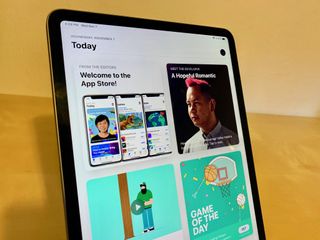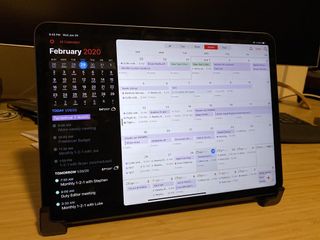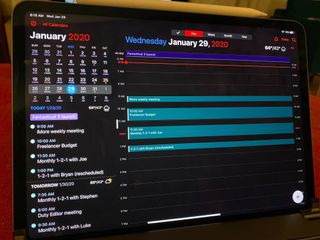Why truly universal Catalyst apps are a great idea

"There's an app for that."
I've been into computers ever since I was a young kid, so I've always been interested in software and apps. But it wasn't until the iPhone and the App Store where it really blew up for me. In fact, I began to make my living writing about apps and games on the iPhone, then eventually, it spread to the iPad as well as Mac apps. And over a decade later, I'm still here, writing about apps.
Ever since I got into this industry, I love finding out about new apps, testing them out, and eventually telling people about how great (or not) they are. But sometimes this passion got expensive when there were three separate versions of an app, and lacking one version would give you an "incomplete" experience.
Thankfully we're on the road to truly universal apps with Catalyst, and this is an excellent idea for the consumer.
Before universal iOS apps, you had to buy one app multiple times

Back when the App Store first launched in 2008, it was just iPhone apps, because the iPad wasn't even available yet. Then when the iPad released in 2010, there came a wave of iPad-specific apps and games, and at some point, popular iPhone apps began to get their own standalone iPad versions. But just because you already had the iPhone version didn't mean anything if it was a paid app — you had to buy it again if you wanted it on your iPad.
As much as I love apps, I always found it a bit annoying that you had to essentially pay twice to have certain apps for both your iPhone and iPad. I get that developers needed to make money to sustain their business of making apps, but it just felt like double-dipping into the wallets of customers. And a lot of the time back then, the iPad version of an app could be nothing but a glorified and blown-up iPhone version. There wasn't much of a difference between the two except that the iPad just had a bigger screen.
Some developers got it though and had their iPad versions take full advantage of what the iPad had to offer, including the larger screen estate for more informative views at-a-glance, and the like. But still, it was hard to justify paying again for the iPad version if someone didn't always use their iPad at the time (it was far less advanced back then).
Master your iPhone in minutes
iMore offers spot-on advice and guidance from our team of experts, with decades of Apple device experience to lean on. Learn more with iMore!
Universal iOS apps were a godsend

At some point, universal apps for iOS became a thing, with one purchase giving users access to the app on both their iPhone and iPad. Eventually, this moved to include Apple TV as well, though that is mostly geared towards games and video streaming. So one purchase of an app or game on your iPhone or iPad, and it would be accessible on your other iPhones, iPads, and even Apple TVs without having to buy it again.
I remember when Fantastical, one of my most-used apps, had separate versions on iPhone and iPad, and there was also the standalone Mac version too. I remember I reluctantly paid for the iPad version of Fantastical 2 way back when, but I used it often when I was working from my iPad. At some point, Flexibits scrapped the idea of having separate iPhone and iPad versions of Fantastical, and eventually just merged them into a single, universal iOS app for about $5. The Mac app was still separate, of course, but at the time, Mac and iOS apps were built differently.
But wouldn't it be great if you just bought an app once and it could be everywhere? With Catalyst, that dream is becoming a reality.
macOS Catalina is the Catalyst for truly universal apps

With macOS Catalina and Xcode 11.4 (in beta), developers are now able to bundle macOS apps with iPadOS and iOS apps, making way for a new wave of "buy/download once, get it everywhere" apps. And coming from a consumer standpoint, this is going to be fantastic.
As I mentioned earlier, there are a lot of useful apps (as well as fun games) that are on the iOS App Store, as well as the Mac App Store. But the problem has always been that they're separate versions, so if they're paid titles, you'll need to dip into your wallet at least twice. But with Catalyst, this may be a thing of the past.
Catalyst essentially allows developers to create macOS versions of their already existing iPad apps. This is because Catalyst brings over UIKit from iOS to the Mac, and lets developers maintain one code base across both platforms. In short — it's a win-win for everyone, mostly.
You may be thinking, "How would iPad apps, with their focus on multitasking and touch gestures, translate onto a Mac, with default keyboard and mouse inputs?" Fortunately, Apple thought of that with Project Catalyst. Any UIKit multitasking gestures get automatically remapped to work with mouse and trackpad inputs. Gestures don't translate well from touch screens to Macs, so those do not get mapped over, but developers can implement hover states for them instead if they desire. Again, most things will be automatic, but some things need to get Mac-ified manually, but still, Catalyst makes it much easier than before.
And with the latest development with Catalyst being the news that developers can bundle macOS apps with iPadOS and iOS apps, we are just one step closer to eliminating App Store headaches. Honestly, I hope to see a lot of the apps I use implement this in future updates because it would make my life a lot easier.
Think about Things. I use Things right now to keep track of tasks that I need to do for work, as well as some personal things I have to take care of. It is my task manager and helps me stay focused on what I need to do, so I have it on my iPhone, iPad, and Mac. But because each version is its own thing, I have had to pay for Things three times just to have a task management system that works for what I need.
If Cultured Code goes with the new Catalyst bundling feature, then I could buy or download the next version of Things once, and it will end up on all of the platforms that matter to me. With a mostly unified interface (iPhone will never quite look like the iPad or Mac version because of limited screen size), you'd already be familiar with how an app works, regardless of the platform you're using it on.
But then we reach the tricky part, and that's price.
Universal apps deserve a fair price point for everyone involved

Now, if more developers began to utilize the Catalyst bundling system for their iPadOS, iOS, and macOS apps, what would be considered "fair" for both the developers and the consumers? After all, developers need to make money, but consumers are clearly tired of subscription models for pretty much everything.
Honestly, I prefer the "pay once" upfront price for each major iteration of an app, because the developers will (or should) continue to update the app for a good while. But with this, each version of an app had its own upfront price point. With macOS Catalina and Catalyst apps creating a universal experience, I think the cost of such an app should be the total of each app as if they were sold separately.
So if Things cost $50 for the Mac version, $20 for the iPad version, and $10 on iPhone, then a completely universal Things should be $80 upfront, and you get it on all three platforms. Of course, if you don't have a Mac or an iPad, then you should be able to still pay separately for the versions that you need. With Catalyst universal apps, it seems it just makes things easier for developers to bundle everything together for a unified experience.
Of course, I feel that a lot of developers are going the route of app subscriptions, much to the annoyance of consumers. I get it — developers need to continue to make money, and getting paid once for an app and then continuing to maintain it for years is just not viable for most anymore. But if that's the case, then developers should consider a price point for a subscription that is actually worth the service that they're offering users, and even consider a way for family sharing. This was the issue with Fantastical's new subscription model — even those who wouldn't mind the $40 a year price could not justify it with no way to share a subscription with other family members, and the only solution was to pay for two subscriptions ($80 for a calendar? No way, José!)
If developers must go the subscription route with universal apps, then they could follow in the footsteps of Darkroom. This move was done tastefully, as anyone who had previously bought any in-app purchase (any, even just one pack of filters), will continue to be able to use all premium features for free. No functionality is lost, unlike with Fantastical. New users will have to pay $4 a month or $20 a year to use Darkroom, or pay a one-time fee of $50 and be done with it.
Price is a bit of a tough subject, but if apps are going the route of being truly universal across all of Apple's platforms, then it needs to be fair for everyone involved, including developers and consumers.
Your thoughts?
Are you excited for the idea of truly universal Catalyst apps? What developers and apps do you hope to see go universal across all Apple platforms? What would you consider fair pricing? Let us know in the comments.
Christine Romero-Chan was formerly a Senior Editor for iMore. She has been writing about technology, specifically Apple, for over a decade at a variety of websites. She is currently part of the Digital Trends team, and has been using Apple’s smartphone since the original iPhone back in 2007. While her main speciality is the iPhone, she also covers Apple Watch, iPad, and Mac when needed. When she isn’t writing about Apple, Christine can often be found at Disneyland in Anaheim, California, as she is a passholder and obsessed with all things Disney, especially Star Wars. Christine also enjoys coffee, food, photography, mechanical keyboards, and spending as much time with her new daughter as possible.
Most Popular






